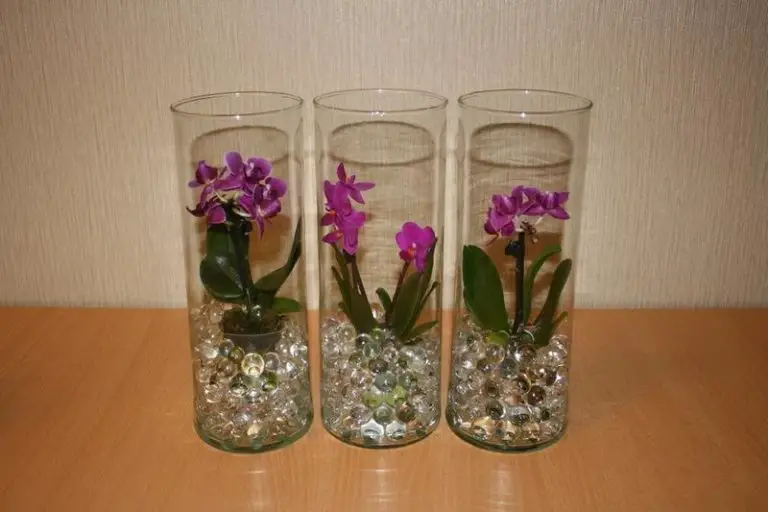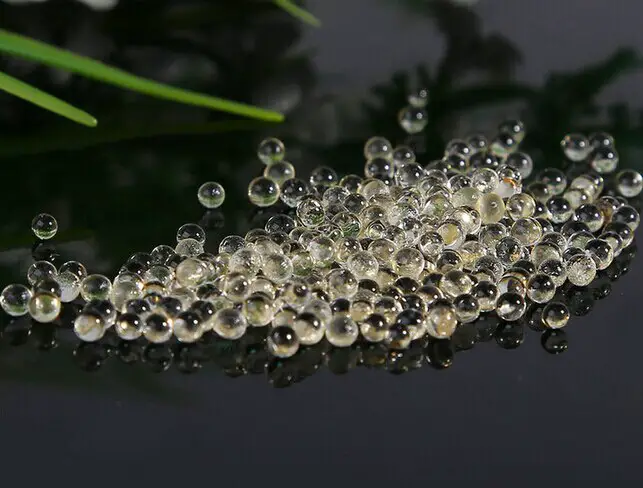More recently, flower growers, especially orchids growers could not even imagine that indoor plants can be grown without a traditional potting mix. Soil substitutes are very popular among modern materials. They fully or partially fulfill the functions of plant nutrition. One of them is water beads here we will discuss growing orchids in water beads and how to plant, grow, and care.

Types and properties of water beads
Water beads are modern substances that can retain a large amount of nutrient moisture. Instead of ordinary soil, polymer granules are placed in a flower pot that can absorb water, hold it for a long time and gradually give it to plants. This property is important for orchids, which are sensitive to excess or lack of moisture and nutrients.
Another name for the substance is water beads. Outwardly, it resembles gelatinous balls or irregular flakes. It is placed in flower pots, mixed with the nutrient substrate, or completely replaced.
Inconsistency, it is a springy substance, colorless or colored in different colors. Serves to extend the intervals between waterings.
The mechanism of action is as follows:
- The water beads absorb moisture and nutrients and gradually releases them with slow evaporation;
- The root system of the orchid, evenly spaced between the granules, penetrates the material and takes food.
This method protects the orchid from drought or waterlogging, and also provides the necessary aeration.
Important! An invaluable property in comparison with ordinary soil is complete sterility. The water beads do not contain pathogens and pest larvae.
When growing orchids in water beads, you do not have to worry that they will become infected with a fungal or bacterial infection. But it is worth considering that ordinary watering should be alternated with nutrient solutions of mineral fertilizers.
Recommended for you Do natural blue orchids Exit: is it dyed or not?
transparent vs colored water beads for plants growing
There are two types of water beads on sale:
| Transparent | A soft consistency material that is added to the main substrate of orchids. |
| Colored | Dense, elastic granules of different colors. Most of them are used for decoration. Their nutritional capacity is significantly less than transparent water beads. |
The transparent water beads are mixed with other components of the orchid mixture pine bark, peat, coconut chips or fiber, fern roots, sphagnum moss. The water beads store nutrients that are released by other ingredients.
Important: It should be noted that the water beads do not moisturize the soil mixture. Orchids first absorb the evaporated moisture from the soil and then from the water beads. This feature allows you to provide plants with moisture, even when the substrate is completely dry. The roots can use the moisture accumulated in the water beads when they germinate into it. This will take about two weeks. It is often sufficient for the roots to be in close contact with the granules.
Elastic water beads are called an aqua primer. Most often, Chinese-made material is on sale. It is produced in the form of balls of the same or different sizes. Less commonly, there are other forms of cubes, pyramids, animal figures. The appearance of the granules and color depends on the capabilities of the company. The production technology is approximately the same for all manufacturers, the material is synthesized from polymer raw materials, by “flashing” copolymers. To attract the attention of buyers, designers develop new shapes and colors.
Tip # 1. Note! The colored water beads serves as a breeding ground for cut flowers. A bouquet of orchids will last much longer in it than in plain water.
water beads are also called Hydrogel is a reusable material. The one that filled the vase of flowers can
dry and store for up to two years, while it does not lose its sorption properties.
Manufacturers assure that this product is an environmentally friendly product, absolutely safe for humans and plants. This is especially important if the family has small children who are attracted to colorful figures.
Take a look at Cymbidium Orchid Types, Origin, Proper Care at Home
Step by step growing orchids in water beads, Planting, care features

Planting Orchid in water beads potting mixture
| Step 1 | Prepare a separate container for beads swelling. |
| Step 2 | Place granules in it and pour water according to the instructions. The most commonly recommended ratio is 1 g (1 teaspoon, without a slide) of water beads per 1 liter of water. The material cannot absorb more water than it should, so water can be poured safely. |
| Step 3 | Withstand 2 – 3 hours |
| Step 4 | In the orchid pot, alternately place the nutrient substrate, shifting it with swollen granules. Fill in with ¼. |
| Step 5 | Place the orchid roots in the pot and continue filling, alternating the water beads with the nutrient mixture. There is no need to compact, the roots need sufficient aeration. |
Planting in colored water beads
This method is used for interior decoration. Use only clear, colorless orchid containers. A root system is installed in a pot and fill with pre-soaked figurines. If desired, the colored granules can be mixed with each other or alternated in layers. Experts recommend covering the roots of orchids with water beads from one manufacturer.
You may also like
adult growing orchids in water beads
If you plan to add water beads for an adult growing orchid, do it like this:
- Pre-soak the granules in water. They will need as much as can be placed in a pot along with the substrate.
- Depressions are made in the soil mixture so as not to damage the roots.
- The swollen gel is placed in the holes.
- Watering orchids.
In the future, irrigation will be needed 5 times less than less.
Does every orchids lover want to know Where To Put Orchids In Your Home?
Do Orchids Root in water beads mixture
Young plants perfectly take root in the water beads mixture. The planting method is the same as in the substrate.
- First, the lower part of the separated process is dipped 1 cm in water;
- Then, it is dipped in a rooting agent, for example, in “Kornevin”;
- The orchid pot is partially filled with water beads and the “baby” is installed;
- Holding the leaves, add the granules to the top.
How to feed orchids in water beads potting mix?
There are many special fertilizers for orchids on the market, both mineral and organic.
The method of their introduction does not differ from what is indicated in the instructions. But together with the growing orchid in water beads, the effectiveness increases significantly.
In an ordinary substrate, the top dressing dissolves and is washed out rather quickly. Water beads absorb nutrients and gradually release them to plant roots. This ensures a long-term metered supply of nutrients. Thus, fertilization is necessary much less frequently, which leads to savings in nutrients.
If you are an orchid lover you must know about the benefits and harmful effects of orchids.
Questions and Answers
Can orchids be planted in a dry growing orchid in water beads, without soaking?
Not worth it! The granules grow very large and can break the roots of the plant. Then, instead of the expected benefit, the orchid can be destroyed.
Which water beads are best for orchids transparent or colored?
Both are good. Transparent is often mixed with a nutrient substrate. If the main goal is decoration, then painted figures are used.
How long can orchids be kept in water beads?
On average 2 years. As a rule, this is the period before the planned transplant. Freshwater beads are placed in a new pot, and the old one is discarded.
